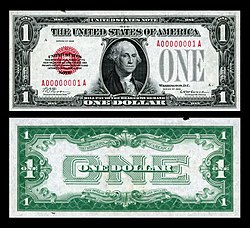Federal Reserve Notes
Federal Reserve Notes featured a green Treasury Seal starting in 1928. This was the only type of currency that, at first, featured the seal over the large engraved word to the right of the portrait. [3]
These notes also carried a seal bearing the identity of the Federal Reserve Bank of issuance. The bank was noted in the black, circular seal to the left of the portrait. This can be seen in the picture at the upper right, with a "7" in the seal. The Federal Reserve Bank of Chicago, responsible for the 7th district of the Federal Reserve System, issued this note. The regional seal is a design facet unique to Federal Reserve Notes, because almost all other types of notes were issued directly by the U.S. Treasury.
The 1928 Federal Reserve Notes were redeemable as per the following legend in the upper left corner of the note: Redeemable in gold on demand at the United States Treasury, or in gold or lawful money at any Federal Reserve Bank. While these notes were issued by the Federal Reserve Banks, they were still obligations of the U.S. Government, as stated: The United States of America will pay to the bearer on demand [so many] dollars. This obligation to exchange FRNs for gold ended in the early 1930s as the United States outlawed the private ownership of gold and left the gold standard in response to the Great Depression.
Design changes
The $5, $10, and $20 denominations were the first to be issued.
- Series of 1928A for $5, $10, and $20 notes resulted from a signature change, and corresponds to Series of 1928 for the $50 and $100 denominations. [4]
- Series of 1928B for $5, $10, and $20 notes; Series of 1928A for $50 and $100 notes; and Series of 1928 for the large denominations reflected a change in the Federal Reserve Seal to contain a letter instead of a number. [5] The four corner numbers were aligned vertically, as well, causing a shift in plate position letters on certain denominations.
- Series of 1928C included only $5, $10, and $20 notes. [4] This series of notes saw very low printing figures as a result of the Great Depression, as only certain districts issued notes. This series, the result of a signature change, is also known for its specific light green Treasury Seal variety. [6]
- Series of 1928D, also the result of a signature change, included only $5 notes and all notes were issued by the Federal Reserve Bank of Atlanta. These 1928D series $5 notes are among the rarest small-size notes in existence today.
This page is based on this
Wikipedia article Text is available under the
CC BY-SA 4.0 license; additional terms may apply.
Images, videos and audio are available under their respective licenses.
























